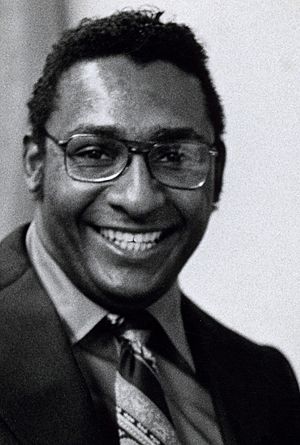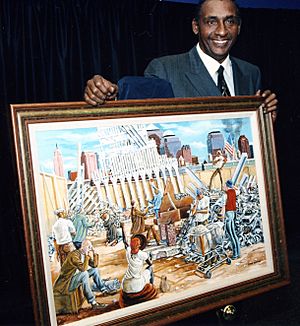Ernie Barnes facts for kids
Ernest Eugene Barnes Jr. (born July 15, 1938 – died April 27, 2009) was a famous American artist. He was known for his special way of drawing people with long, stretched-out bodies that showed movement. Before becoming a full-time artist, he was also a professional football player, an actor, and an author.
Contents
Early Life and Art Dreams
Growing Up in Durham
Ernest Barnes Jr. was born in Durham, North Carolina, in a time called the Jim Crow era. This was a period when laws kept Black and white people separate, and Black people faced unfair treatment. His family called him "June." His father worked for a tobacco company, and his mother worked for a lawyer named Frank L. Fuller Jr.
When his mother took him to work, Mr. Fuller let young Ernest look at his art books and listen to classical music. Ernest loved looking at the paintings by famous artists like Toulouse-Lautrec and Michelangelo. By the time he was in first grade, he already knew a lot about these art masters. Even though he couldn't visit many museums because of segregation, he learned to understand great art.
Finding His Path
Ernest was a quiet child who was often teased. He found comfort in his sketchbooks, drawing in peaceful spots away from others. One day, his masonry teacher and weightlifting coach, Tommy Tucker, found him drawing. Coach Tucker saw Ernest's talent and encouraged him to get stronger. This meeting changed Ernest's life. He started working out and became the captain of his high school football team. He also became a state champion in the shot put.
College and Art
In 1956, Ernest graduated from Hillside High School with many sports scholarships. Because of segregation, he couldn't go to nearby white universities. Instead, he went to North Carolina College at Durham, an all-Black school, on a full sports scholarship. He studied art there.
When he was 18, Ernest went on a college art trip to the North Carolina Museum of Art. He asked where he could find art by Black artists, and the museum guide said, "Your people don't express themselves that way." Years later, in 1979, Ernest Barnes had his own art show at that very museum!
North Carolina Central University gave him an honorary degree in Fine Arts in 1990. In 1999, he received "The University Award," a top honor from the University of North Carolina.
Life as a Professional Football Player
Playing for the Colts and Titans
In 1959, Ernie Barnes was picked by the Baltimore Colts football team. He was also briefly picked by the Washington Redskins, but they changed their mind when they found out he was Black.
In 1960, a sportswriter called him "Ernie Barnes" instead of Ernest, and the name stuck. He later played for the Titans of New York. He didn't like playing for the Titans because he felt the team wasn't well-organized. After a teammate died, Ernie asked to leave the team.
Chargers and Broncos
Ernie then joined the Los Angeles Chargers and later the San Diego Chargers. While playing football, he also worked with young people and wrote for a local newspaper. He even had his first TV interview as an artist and football player in 1962.
Later, he played for the Denver Broncos. His coach, Jack Faulkner, would fine him for sketching during team meetings. But Ernie kept drawing! He would often sketch during breaks in games, capturing the movements and feelings of the players. His teammates even called him "Big Rembrandt" because of his art.
End of His Football Career
In 1965, Ernie signed with a team in Canada, the Saskatchewan Roughriders. But he broke his right foot in a game, which ended his professional football career.
Becoming a Full-Time Artist
After football, Ernie wanted to become the official artist for the NFL. He met New York Jets owner Sonny Werblin, who loved Ernie's art. Werblin paid for Ernie to bring his paintings to New York City. Art critics saw his work and said he was a very expressive painter.
Werblin then did something unusual: he paid Ernie a salary as a player, but told him to focus on his art instead of playing football. Werblin believed Ernie had more value as an artist. In 1966, Ernie had his first art show in New York City, and all his paintings sold!
In 1995, Ernie wrote his autobiography called From Pads to Palette, which told the story of how he went from being a football player to a famous artist.
Ernie Barnes's Amazing Artwork
Unique Style and Framing
Ernie Barnes's art has a very special look. His paintings often show people with long, stretched-out bodies, full of energy and movement. He learned from his college art teacher, Ed Wilson, to paint from his own life experiences. Ernie said his time as a football player helped him understand how the body moves, which he then showed in his art.
Ernie also framed his paintings in a unique way, using old, worn-out wood. This was a special tribute to his father, who worked very hard. He noticed an old fence at his family home after his father passed away. He realized the old wood looked perfect with his paintings, so he used it to honor his father.
The Meaning of Closed Eyes
One interesting thing about many of Ernie Barnes's paintings is that the people in them have their eyes closed. He explained that he did this to show how people are often "blind" to each other's true selves. He wanted to show that we often judge people by their looks or where they come from, instead of seeing their inner gifts and strengths. He believed that if we truly look at others, we see their humanity.
"The Beauty of the Ghetto"
In the 1960s, there was a movement called "Black is beautiful" that encouraged Black people to be proud of who they are. Ernie Barnes created an art show called The Beauty of the Ghetto with 35 paintings. This show traveled to many cities from 1972 to 1979.
Ernie wanted to show the beauty and spirit of life in Black communities. He said his art was "a pictorial background for an understanding into the aesthetics of black America." He wanted to challenge people to see how beautiful life could be, even in difficult places.
Famous Sports Art
Ernie Barnes created many paintings about different sports like hockey, boxing, basketball, and gymnastics.
- In 1984, he was named the "Sports Artist of the 1984 Olympic Games" for his amazing art that captured the spirit of the Olympics.
- In 1987, he painted Fastbreak, a famous painting of the World Champion Los Angeles Lakers basketball team.
- In 1996, the National Basketball Association (NBA) asked him to create a painting for their 50th anniversary. This painting, called The Dream Unfolds, hangs in the Naismith Memorial Basketball Hall of Fame.
"The Bench" Painting
One of Ernie Barnes's most personal paintings is called The Bench. He painted it in less than an hour after watching his first professional football game from the sidelines in 1959. He never sold this painting, even though he received many offers. It stayed with him throughout his life. In 2014, his wife gave The Bench to the Pro Football Hall of Fame for their permanent collection.
"The Sugar Shack" Painting
Ernie Barnes created his most famous painting, The Sugar Shack, in 1971. This painting became super popular when it was used in the opening and closing credits of the TV show Good Times (1976-1979). It was also on the cover of Marvin Gaye's 1976 album I Want You.
Ernie said he painted The Sugar Shack based on his childhood memories of not being allowed to go to dances. He wanted the painting to show the rhythm and energy of dance, and how African Americans use rhythm to express themselves. The original painting is now owned by actor Eddie Murphy. Another version of the painting was sold for $15.3 million in 2022!
Music Album Covers
Ernie Barnes's art has been featured on several music album covers:
- The Sugar Shack on Marvin Gaye's 1976 I Want You
- The Disco on Faith, Hope & Charity's 1978 self-titled album
- Donald Byrd and 125th Street, NYC on Donald Byrd's 1979 self-titled album
- Late Night DJ on Curtis Mayfield's 1980 Something to Believe In
- The Maestro on The Crusaders' 1984 Ghetto Blaster
- Head Over Heels on The Crusaders' 1986 The Good and Bad Times
- In Rapture on B.B. King's 2000 Makin Love is Good For You
Other Important Artworks
In 1992, after the 1992 Los Angeles riots, Mayor Tom Bradley used Ernie's painting Growth Through Limits on a billboard to inspire people in the city.
After the tragic events of 9/11 in 2001, Ernie created the painting In Remembrance. This painting was shown at the Seattle Art Museum and later given to the African American Museum in Philadelphia. Money from prints of this painting went to a fund for children of police and fire personnel who died in the line of duty.
- In 2005, rapper Kanye West asked Ernie to create a painting about his life-changing car crash. The painting, A Life Restored, shows a large angel reaching out to a smaller figure of West.
Ernie Barnes in Television and Movies
Ernie Barnes also appeared on TV and in movies.
- He was on the game show To Tell the Truth in 1967, where people tried to guess he was the football player turned artist.
- He acted in the movies Number One (1969) and Doctors' Wives (1971).
- He helped create a TV special called Super Comedy Bowl in 1971, which featured athletes and celebrities.
- His artwork was used in many TV shows like Columbo, The White Shadow, and Soul Food. It also appeared in movies like Drumline and Boyz n the Hood.
- In 1981, he played baseball player Josh Gibson in the TV movie Don't Look Back: The Story of Leroy 'Satchel' Paige.
- The 2016 movie Southside with You, about Barack and Michelle Obama's first date, shows them visiting an art exhibition featuring Ernie Barnes's work.
Death
Ernie Barnes passed away on April 27, 2009, in Los Angeles, California, from a type of cancer called myeloid leukemia. His ashes were scattered in his hometown of Durham, North Carolina, and at a beach in Carmel, California, one of his favorite places.
Posthumous Recognition
In 2019, Ernie Barnes was honored in Durham, North Carolina, for his important contributions that helped shape the city.
Images for kids





